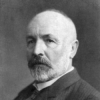Georg Cantor

Georg Cantor
Georg Ferdinand Ludwig Philipp Cantorwas a German mathematician. He invented set theory, which has become a fundamental theory in mathematics. Cantor established the importance of one-to-one correspondence between the members of two sets, defined infinite and well-ordered sets, and proved that the real numbers are more numerous than the natural numbers. In fact, Cantor's method of proof of this theorem implies the existence of an "infinity of infinities". He defined the cardinal and ordinal numbers and their arithmetic. Cantor's work...
NationalityGerman
ProfessionMathematician
Date of Birth3 March 1845
CountryGermany